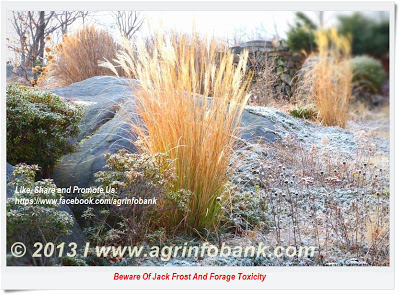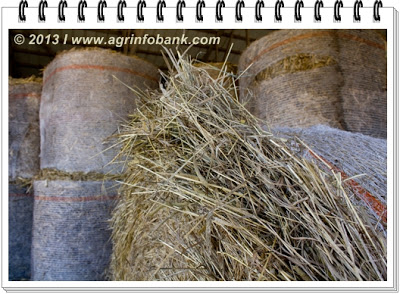Agriculture

The warm-season annual grasses in the sorghum family and other closely related species are capable of becoming toxic to livestock after a frost event. Those species contain compounds called cyanogenic glucosides that convert quickly to prussic acid in freeze-damaged plant tissue. Prussic acid is also known as hydrogen cyanide - the very substance of murder mysteries!
 The potential toxicity after frost varies by species. Sudangrass varieties are low to intermediate in cyanide poisoning potential, sudangrass hybrids are intermediate, sorghum-sudangrass hybrids and forage sorghums are intermediate to high, and grain sorghum is high to very high and is most likely to be toxic after a frost. Piper sudangrass has low prussic acid poisoning potential. Pearl millet and foxtail millet have very low levels of cyanogenic glucosides and rarely cause toxicity.
The potential toxicity after frost varies by species. Sudangrass varieties are low to intermediate in cyanide poisoning potential, sudangrass hybrids are intermediate, sorghum-sudangrass hybrids and forage sorghums are intermediate to high, and grain sorghum is high to very high and is most likely to be toxic after a frost. Piper sudangrass has low prussic acid poisoning potential. Pearl millet and foxtail millet have very low levels of cyanogenic glucosides and rarely cause toxicity.
Other species that have potential to have toxic levels of prussic acid after frost are Johnsongrass, chokecherry, black cherry, indiangrass, elderberry, and some varieties of birdsfoot trefoil.
Animal symptoms of prussic acid poisoning: Animals can die within minutes if they consume forages such as the sorghum species that contain high concentrations of prussic acid in the plant tissue. The prussic acid is released from the forage and interferes with oxygen transfer in the blood stream of the animal, causing it to die of asphyxiation. Before death, symptoms include excess salivation, difficult breathing, staggering, convulsions, and collapse.
 Ruminants are more susceptible to prussic acid poisoning than horses or swine because cud chewing and rumen bacteria help release the cyanide from plant tissue.
Ruminants are more susceptible to prussic acid poisoning than horses or swine because cud chewing and rumen bacteria help release the cyanide from plant tissue.
Factors that increase prussic acid toxicity: Plants growing under high nitrogen levels or in soils deficient in phosphorus or potassium will be more likely to have high cyanide poisoning potential. After frost damage, cyanide levels will likely be higher in fresh forage as compared with silage or hay. This is because cyanide is a gas and dissipates as the forage is wilted and dried for making silage or dry hay.
Young, rapidly growing plants of species that containing cyanogenic glucosides will have the highest levels of prussic acid. After a frost, cyanide is more concentrated in young leaves than in old leaves or stems. New growth of sorghum species following frost is dangerously high in cyanide. When sorghum species regrow after a drought, the new growth is also dangerously high in cyanide. Pure stands of indiangrass (not common in Ohio and nearby regions) can have lethal levels of cyanide if they are grazed when the plants are less than 8 inches tall.
Forage with prussic acid potential that has undergone silage fermentation is generally safe to feed. To be extra cautious, wait 5 to 7 days after a frost before chopping for silage. If the plants appear to be drying down quickly after a killing frost, it is safe to ensile within a shorter time period after the frost.
Delay feeding silage for 8 weeks after ensiling. If the forage likely contained high levels of cyanide at the time of chopping, hazardous levels of cyanide might remain and the silage should be analyzed before feeding.
The safest management is to wait a few days after a killing frost before grazing pure legume stands - wait until the forage begins to dry from the frost damage. It is also a good idea to make sure animals have some dry hay before being introduced to lush fall pastures that contain significant amounts of legumes.
- Clines
ClinesA cline is one form of geographic variation in which characteristics of a species change gradually through the species? geographic range. Many plant and animal species have populations that differ in terms of their morphological, physiological,...
- Legumes
Legumes Legumes, including peas and beans, are among the most important staple food crops worldwide. Legumes are also planted among other crops because of their ability to enrich soil nitrogen content. Legumes are plants of the pea or bean family classed...
- Panicum Tyrgidum: A Resilient Fodder And Excellent Biofuel Crop
Asad Saeed, Mohsin Tanveer, Shahbaz Atta Tung, Ali Ahsan BajwaGlobal environment is rapidly changing due to increase in global warming, associated with CO2 concentration leading to ...
- Tips For Winter Supplementation Of Cattle
By: Clay P. Mathis Developing a cost-effective supplementation program depends on just two things ? first, identify the nutrient (or nutrients) most limiting to productivity and provide it at the lowest cost. Just as important, however, is identifying...
- Winter Gardening Tips
By Tom OderOne of the most frequently asked questions about winter gardening is whether extreme temperature swings will harm or kill ornamental plants. In general, the answer is "no." Plants have a genetic ability to sense atmospheric changes and adjust...
Agriculture
Beware Of Jack Frost And Forage Toxicity
Wed, 2012-09-26 12:14
Fall is in the air and Jack Frost will strike sooner or later. When he does, questions always arise concerning the dangers of feeding frosted forages. A very few forage species can be extremely toxic soon after a frost.

The warm-season annual grasses in the sorghum family and other closely related species are capable of becoming toxic to livestock after a frost event. Those species contain compounds called cyanogenic glucosides that convert quickly to prussic acid in freeze-damaged plant tissue. Prussic acid is also known as hydrogen cyanide - the very substance of murder mysteries!

Other species that have potential to have toxic levels of prussic acid after frost are Johnsongrass, chokecherry, black cherry, indiangrass, elderberry, and some varieties of birdsfoot trefoil.
Animal symptoms of prussic acid poisoning: Animals can die within minutes if they consume forages such as the sorghum species that contain high concentrations of prussic acid in the plant tissue. The prussic acid is released from the forage and interferes with oxygen transfer in the blood stream of the animal, causing it to die of asphyxiation. Before death, symptoms include excess salivation, difficult breathing, staggering, convulsions, and collapse.

Factors that increase prussic acid toxicity: Plants growing under high nitrogen levels or in soils deficient in phosphorus or potassium will be more likely to have high cyanide poisoning potential. After frost damage, cyanide levels will likely be higher in fresh forage as compared with silage or hay. This is because cyanide is a gas and dissipates as the forage is wilted and dried for making silage or dry hay.
Young, rapidly growing plants of species that containing cyanogenic glucosides will have the highest levels of prussic acid. After a frost, cyanide is more concentrated in young leaves than in old leaves or stems. New growth of sorghum species following frost is dangerously high in cyanide. When sorghum species regrow after a drought, the new growth is also dangerously high in cyanide. Pure stands of indiangrass (not common in Ohio and nearby regions) can have lethal levels of cyanide if they are grazed when the plants are less than 8 inches tall.
Grazing Precautions
The following guidelines will help you avoid danger to your livestock this fall when feeding species with prussic acid poisoning potential:- Do not graze on nights when frost is likely. High levels of the toxic compounds are produced within hours after a frost.
- Do not graze after a killing frost until plants are dry, which usually takes 5 to 7 days.
- After a non-killing frost, do not allow animals to graze for two weeks because the plants usually contain high concentrations of toxic compounds.
- New growth may appear at the base of the plant after a non-killing frost. If this occurs, wait for a hard, killing freeze, then wait another 10 to 14 days before grazing the new growth.
- Don't allow hungry or stressed animals to graze young growth of species with prussic acid potential.
- Graze or greenchop sudangrass only after it is 18 inches tall. Sorghum-sudangrass should be 30 inches tall before grazing. Never graze immature growth.
- Do not graze wilted plants or plants with young tillers.
- Green-chopping the frost-damaged plants will lower the risk compared with grazing directly, because animals be less likely to selectively graze damaged tissue. However, the forage can still be toxic, so feed greenchop with great caution after a frost.
- Feed greenchopped forage within a few hours, and don't leave greenchopped forage in wagons or feed bunks overnight.
Forage with prussic acid potential that has undergone silage fermentation is generally safe to feed. To be extra cautious, wait 5 to 7 days after a frost before chopping for silage. If the plants appear to be drying down quickly after a killing frost, it is safe to ensile within a shorter time period after the frost.
Delay feeding silage for 8 weeks after ensiling. If the forage likely contained high levels of cyanide at the time of chopping, hazardous levels of cyanide might remain and the silage should be analyzed before feeding.
What about frosted alfalfa, clover, and grasses?
Other common forages such as alfalfa, clovers, and cool-season perennial grasses do NOT produce toxic compounds after a frost. There is different concern, however, when grazing alfalfa or clovers after a frost - and that is bloat. One or two days after a hard frost, the risk of bloat is higher for animals grazing legumes. The bloat risk is highest with grazing pure legume stands, and least when grazing stands having mostly grass and only low amounts of legumes present.The safest management is to wait a few days after a killing frost before grazing pure legume stands - wait until the forage begins to dry from the frost damage. It is also a good idea to make sure animals have some dry hay before being introduced to lush fall pastures that contain significant amounts of legumes.
Source URL: http://beefmagazine.com/pasture-health/beware-jack-frost-and-forage-toxicity
- Clines
ClinesA cline is one form of geographic variation in which characteristics of a species change gradually through the species? geographic range. Many plant and animal species have populations that differ in terms of their morphological, physiological,...
- Legumes
Legumes Legumes, including peas and beans, are among the most important staple food crops worldwide. Legumes are also planted among other crops because of their ability to enrich soil nitrogen content. Legumes are plants of the pea or bean family classed...
- Panicum Tyrgidum: A Resilient Fodder And Excellent Biofuel Crop
Asad Saeed, Mohsin Tanveer, Shahbaz Atta Tung, Ali Ahsan BajwaGlobal environment is rapidly changing due to increase in global warming, associated with CO2 concentration leading to ...
- Tips For Winter Supplementation Of Cattle
By: Clay P. Mathis Developing a cost-effective supplementation program depends on just two things ? first, identify the nutrient (or nutrients) most limiting to productivity and provide it at the lowest cost. Just as important, however, is identifying...
- Winter Gardening Tips
By Tom OderOne of the most frequently asked questions about winter gardening is whether extreme temperature swings will harm or kill ornamental plants. In general, the answer is "no." Plants have a genetic ability to sense atmospheric changes and adjust...
